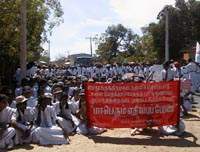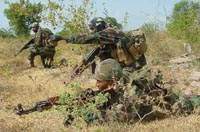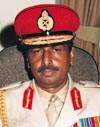 |
|||||||
Stock taking after deadlines end on Friday In
the 19 year long sepa ratist war, the first guer rilla to die was
"Lieutenant" Sathianathan alias Sankar. He was killed
in a shoot-out with Army commandos on October 27, 1982 in the Jaffna
peninsula. Dawn
that day also saw another significant incident. A guerrilla
unit led by Charles Anthony, a close confidant of their leader Velupillai
Prabhakaran, attacked the Chavakachcheri Police Station, killing
three policemen. They seized
a cache of weapons - nine 303 rifles, two sub -machine guns, two
shotguns and a revolver. This incident
was to signal the beginning of the closure of police stations in
the Jaffna peninsula. Nineteen years later, for a fourth time in succession, the guerrillas and a Government are locked in a peace process.
Since last December
24, when a cessation of hostilities came into effect and was formalised
with an open-ended ceasefire on February 22, only a single soldier
died in a stray incident. That was when
he chose to venture out against orders last Thursday. He fired at
two female guerrilla cadres and was shot dead in the stretch of
no man's land, or separation zone, that divides the Army and Liberation
Tigers of Tamil Eelam (LTTE) checkpoint at Muhamalai. Whilst the dates
for peace talks in Thailand, where outstanding matters and core
issues are due to be discussed, still remains elusive, both sides
have been busy. In the months
when guns felt silent in the battle zones of the North and East,
the LTTE has launched a concerted recruitment campaign, particularly
in the East. Whilst the new recruits are being put through a rigorous
training campaign, the armed cadres have vacated their camps to
undergo more intensive training. Induction of
weapons is going on at a pace, contrary to claims by the guerrillas.
Both local and foreign intelligence sources have confirmed recent
shipments have included "extended range" artillery and
mortar shells among others. There are serious
concerns in the intelligence community that the guerrillas were
also seeking missiles for use at land or sea. Even if their
fears are true, stepped up measures to track them down, like aggressive
patrolling in the seas, are measures the Government may not want
to embark now. This is for
fears it would derail the peace process. The sequence of events
following the July 13 episode involving two trawlers
(SITUATION REPORT - July 21) clearly underscores this fragile
situation. If military
preparedness has continued to remain a priority with efforts to
boost the guerrilla strength, which intelligence sources estimate
to be at least 30,000 (inclusive of the now expanding police force),
stepping up measures to generate higher income has also become a
high priority. Varied levels of "taxation" the LTTE has
put into effect is part of this effort. The expanding "civilian
administrative machinery," a guerrilla "judicial system"
and widening of their "police" network with the opening
of new police stations, further bolsters measures. Tamil expatriates
in the West, leading professionals in their field, have taken time
off from their chores to visit Wanni to advise on specific development
projects, which the guerrillas want to launch. In this backdrop,
the LTTE has not changed its standpoint in insisting on an Interim
Administration for the North and East when the Thailand talks do
begin. Of course, the
Government has made it clear it wants to insist on a guerrilla commitment
to discuss core issues. And this week, Prime Minister Ranil Wickremesinghe
told The New York Times in an interview during his
US visit "the Court system of Sri Lanka will operate, so human
rights can be safeguarded, and it can be transparent. It will be
difficult for the interim administration to operate otherwise.." That assertion makes clear the Government expects the guerrillas to give up their own "judicial system" and consequently their own "Police" force too.Although there has been no formal response so far, it is almost certain that the guerrillas will not agree to abandon the systems they have developed, to accept an interim administration. Though much
after the Ceasefire Agreement of February 22, it has dawned on the
defence establishment on the need to ensure the security forces
maintain a high level of preparedness and are adequately equipped.If
financial allocations to the security forces in particular were
drastically pruned down with offensive military operations coming
to an end with the Ceasefire, the Government has been forced to
take a second look into priority areas. Among them
are the Sri Lanka Air Force (SLAF) and the Sri Lanka Navy (SLN)
where there is an acute need for spares that have forced almost
half the items on their inventories to idle. Whilst training
programmes are under way for troops, it is no secret that the Government
has also successfully sought the help of other countries in this
regard. Some one hundred commandos and Special Forces troops will
receive specialised training in India, among other matters, on counter
terrorism and anti-hijack techniques. This is the
first time India has offered such training since the arrival here
of the Indian Peace Keeping Force (IPKF) under the Indo-Sri Lanka
Agreement of 1987. However, India has continued to provide placements
for officers of Sri Lankan security forces in military institutions
in that country. China has offered
military assistance to Sri Lanka. During a visit to Beijing in June
this year, Defence Minister Tilak Marapana discussed with the Chinese
authorities a deal for the Sri Lanka Navy to procure gunboats. A
contract for the procurement had been signed during the previous
regime but Admiral Daya Sandagiri, who assumed office as Commander
of the Navy, took strong objection to the deal on the grounds that
the prices were high. The Sunday
Times learns that Mr. Marapana is now reviewing the deal on the
basis of the findings of a Committee headed by the Interior Ministry
Secretary M.N. Junaid. The Committee was appointed to examine the
agreement in the wake of Vice Admiral Sandagiri's objections. Assistance from
the United States has been continuing under their Joint Combined
Exercise and Training (JCET) programme. At present a US team is
training its Sri Lankan counterparts somewhere in the South under
"Operation Balanced Style." A proposal
is now before Cabinet for the signing of an agreement between the
United States Air Force and the Sri Lanka Air Force for joint training
exercises among other matters. Assistance from
the US has also been forthcoming for VIP security and improving
intelligence services. Enhanced military
assistance to Sri Lanka is expected to be one of the subjects likely
to be discussed when Pakistani President Gen. Pervaiz Musharaff
arrives here on Tuesday on a two day visit. The Government
has also embarked on improving and strengthening the defence machinery.
One of the
important measures in this regard will be the introduction of legislation
to set up a Joint Services Command. The Army, Navy
and Air Force have already been told to come up with detailed recommendations
in this regard including how the defence establishment should be
structured. Since the death
of "Lieut." Sathianathan on October 12, 1982, the LTTE
says 17,637 of its cadres (13,875 male and 3762 female) have been
killed until June 30 this year. The largest number was killed in
1997 during "Operation Jaya Sikurui" (Victory Assured),
which took a toll of 2103 cadres, 1596 males and 507 females. Since 1983,
according to Brigadier Sanath Karunaratne, Military Spokesman, 14,063
soldiers were killed and a further 2549 were missing in action. Hence, when both the Government and the LTTE begin stock taking next week, that is after August 2, when all time frames in the Ceasefire Agreement come to an end, these factors will undoubtedly be at the back of their minds. |
|||||||
|
Situation Report Archives
Copyright © 2001 Wijeya Newspapers
Ltd. All rights reserved. |
|||||||


 nation's
top most officer in the defence establishment at one time
and now Sri Lanka's Ambassador to Brazil, General Rohan de
S. Daluwatte, has thrown an open challenge to his critics
- If any one can prove that either my wife or I own any houses
or school in the United States and have bank accounts in a
foreign country (other than in Los Angeles), I am prepared
to resign my diplomatic assignment.
nation's
top most officer in the defence establishment at one time
and now Sri Lanka's Ambassador to Brazil, General Rohan de
S. Daluwatte, has thrown an open challenge to his critics
- If any one can prove that either my wife or I own any houses
or school in the United States and have bank accounts in a
foreign country (other than in Los Angeles), I am prepared
to resign my diplomatic assignment.